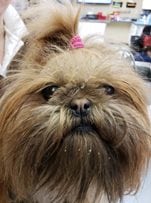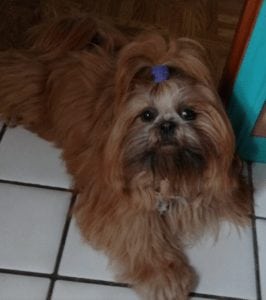Samantha’s Stuffy Sniffer
Meet Samantha – she is a lovely 1½ year old Shih Tzu. We first met Samantha when she was 9 weeks old at her new puppy wellness visit with Dr. Whitmer. During her visit, Samantha was a typical puppy – playful, outgoing, and wiggly! There was one problem though, and Dr. Whitmer noticed it right away. Samantha was born with stenotic nares (narrowed nostrils) which is a condition common in brachycephalic (flat faced) dogs. Stenotic nares can occur alone, or in combination with other abnormalities which together form a condition called Brachycephalic Obstructive Airway Syndrome or BOAS.
Samantha’s family was head over heels with her from the moment they brought her home, and it was disappointing to get the news that she had a medical problem so early in life. Dr. Whitmer explained to her family that this condition causes difficulty breathing because of the narrowing of the nostrils. Dogs normally breathe through their noses, except when panting to cool themselves off. In Samantha’s case, she was trying to breathe through her nose but wasn’t able to move much air – she made a lot of snuffling/snorting noises and even had some bubbles present at the openings of her nostrils because her normal secretions couldn’t drain properly. If left untreated, Dr. Whitmer explained, this could lead to more serious problems such as: sleep apnea, decreased cerebral (brain) oxygenation, and exercise intolerance. Not what a puppy of only 9 weeks old should be facing!
Brachycephalic Obstructive Airway Syndrome is present to some degree in almost every dog bred to have a shortened snout. Some of the most extreme examples of brachycephalic dogs include: Pugs, English Bulldogs, Pekingese, and Shih Tzu’s. Although these breeds are some of the most affected, other breeds with shortened snouts like Mastiffs, Boston Terriers, and Boxers are also frequently affected. BOAS is a term used to describe the presence of one or more of the following abnormalities:
- Stenotic nares – pinched or narrow nostrils
- Hypoplastic trachea – narrowed trachea / wind-pipe
- Elongated soft palate – excess tissue at top of the throat
- Everted laryngeal saccules – pockets of tissue in the throat that bulge outward and narrow the airway
Dogs suffering from BOAS typically show signs of respiratory difficulty even during normal activity. Loud or labored breathing is one of the most common signs and the English Bulldog is the poster child for this. You can usually hear a Bulldog from the next room, even at rest. It is recommended that BOAS be identified and treated as early in life as possible to improve long term function and help prevent secondary irreversible irritation/scarring of tissues in the head and neck. Although some of the abnormalities associated with BOAS can be corrected with surgery, affected dogs will never be “normal” – there is just no getting around the fact that dogs were meant to have noses!
Let’s get back to Samantha. Her family wanted to make sure that she had the best possible start in life. They also wanted to find out if she was affected by other components of BOAS that needed to be addressed. Dr. Whitmer discussed the options with her family and together, they decided to proceed with surgery to correct her nose and remove a misplaced baby tooth that was causing her some discomfort. The surgery was scheduled for a couple weeks later with the plan to examine Samantha closely for an elongated soft palate or other BOAS abnormalities while she was under anesthesia.
The day of Samantha’s surgery came, and she was an excellent patient in the hospital. Full of wiggles and kisses! Once under anesthesia, Dr. Whitmer was happy to find that her soft palate was a normal shape and length and she was not showing other signs of BOAS – finally some good news! Here is a picture of Samantha’s nose before the correction was performed.
True to her personality, Samantha was rocking her “wild child” hairdo on the day of surgery!
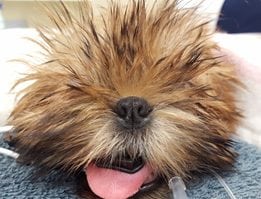
Here is a close up of her nose… not much room for air to move…
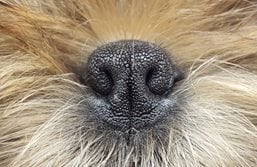
The surgery Samantha had is called an Alar Wing Amputation. Essentially, the bottom most portion of the side of each naris is removed as well as some of the deeper tissue inside her nose to allow for air to flow freely. There are several other surgical techniques which can be used to correct stenotic nares, but for most dogs, Alar Wing Amputation provides the best post-op function while maintaining a cosmetically appealing look. Here is Samantha’s immediate post-op picture – much more room for air to move!
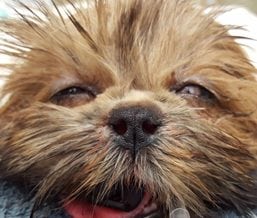
Two weeks later, and Samantha was back for her surgical follow-up appointment with Dr. Whitmer. Her owners were thrilled with her progress and the first thing they mentioned was how much more active she was. They were also surprised to note that she was spending a LOT more time sniffing things – her mom said it was like she had never smelled anything before! She healed beautifully and was breathing comfortably through her new, wider nostrils.
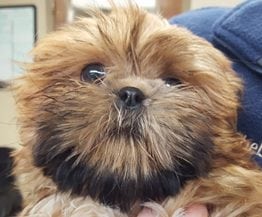
The prognosis for dogs with mild to moderate BOAS is generally good, especially when surgical correction is pursued at a young age. These dogs do present some challenges throughout life, including increased risk of heat stroke and the need to protect their airway carefully during anesthesia, but we fully expect Samantha to lead a long, happy, and healthy life!
Samantha was in to see Dr. Whitmer recently for her annual wellness exam and her owners report that she is doing great – they are so pleased with her care that her mom wrote Dr. Whitmer a poem that we would like to share here with her permission.
Breathing is much easier for Sammy my pet,
Thanks to Dr. Whitmer a very skilled vet
After Dr. Whitmer’s wonderful work,
Sammy and I both breathe easier for sure
It’s such a relief for our family to know,
The perfect workings of Sammy’s cute little nose!
Here is a recent picture of Samantha… we’re glad to see she’s back to rocking her “wild child” look!
